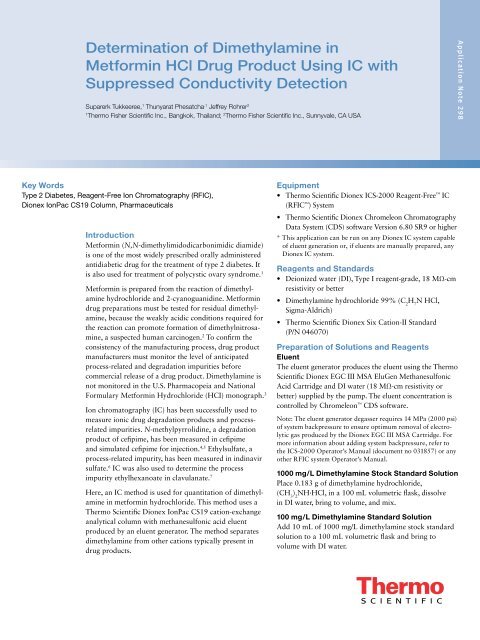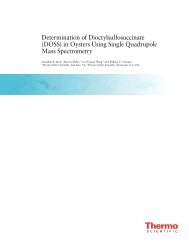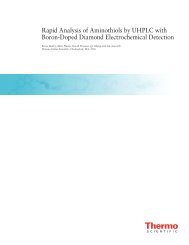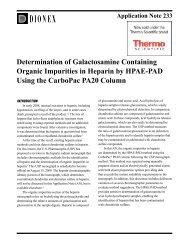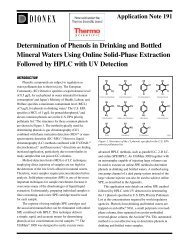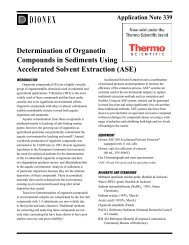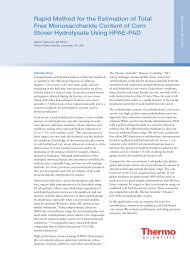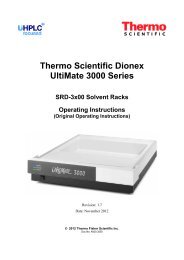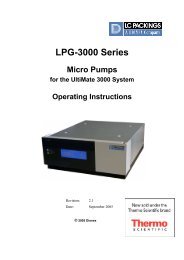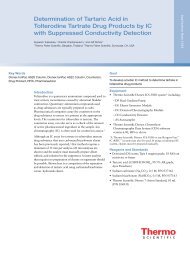Determination of Dimethylamine in Metformin HCl Drug ... - Dionex
Determination of Dimethylamine in Metformin HCl Drug ... - Dionex
Determination of Dimethylamine in Metformin HCl Drug ... - Dionex
Create successful ePaper yourself
Turn your PDF publications into a flip-book with our unique Google optimized e-Paper software.
<strong>Determ<strong>in</strong>ation</strong> <strong>of</strong> <strong>Dimethylam<strong>in</strong>e</strong> <strong>in</strong><br />
Metform<strong>in</strong> <strong>HCl</strong> <strong>Drug</strong> Product Us<strong>in</strong>g IC with<br />
Suppressed Conductivity Detection<br />
Suparerk Tukkeeree, 1 Thunyarat Phesatcha ,1 Jeffrey Rohrer2 1 2 Thermo Fisher Scientific Inc., Bangkok, Thailand; Thermo Fisher Scientific Inc., Sunnyvale, CA USA<br />
Key Words<br />
Type 2 Diabetes, Reagent-Free Ion Chromatography (RFIC),<br />
<strong>Dionex</strong> IonPac CS19 Column, Pharmaceuticals<br />
Introduction<br />
Metform<strong>in</strong> (N,N-dimethylimidodicarbonimidic diamide)<br />
is one <strong>of</strong> the most widely prescribed orally adm<strong>in</strong>istered<br />
antidiabetic drug for the treatment <strong>of</strong> type 2 diabetes. It<br />
is also used for treatment <strong>of</strong> polycystic ovary syndrome. 1<br />
Metform<strong>in</strong> is prepared from the reaction <strong>of</strong> dimethylam<strong>in</strong>e<br />
hydrochloride and 2-cyanoguanid<strong>in</strong>e. Metform<strong>in</strong><br />
drug preparations must be tested for residual dimethylam<strong>in</strong>e,<br />
because the weakly acidic conditions required for<br />
the reaction can promote formation <strong>of</strong> dimethylnitrosam<strong>in</strong>e,<br />
a suspected human carc<strong>in</strong>ogen. 2 To confirm the<br />
consistency <strong>of</strong> the manufactur<strong>in</strong>g process, drug product<br />
manufacturers must monitor the level <strong>of</strong> anticipated<br />
process-related and degradation impurities before<br />
commercial release <strong>of</strong> a drug product. <strong>Dimethylam<strong>in</strong>e</strong> is<br />
not monitored <strong>in</strong> the U.S. Pharmacopeia and National<br />
Formulary Metform<strong>in</strong> Hydrochloride (HCI) monograph. 3<br />
Ion chromatography (IC) has been successfully used to<br />
measure ionic drug degradation products and processrelated<br />
impurities. N-methylpyrrolid<strong>in</strong>e, a degradation<br />
product <strong>of</strong> cefipime, has been measured <strong>in</strong> cefipime<br />
and simulated cefipime for <strong>in</strong>jection. 4,5 Ethylsulfate, a<br />
process-related impurity, has been measured <strong>in</strong> <strong>in</strong>d<strong>in</strong>avir<br />
sulfate. 6 IC was also used to determ<strong>in</strong>e the process<br />
impurity ethylhexanoate <strong>in</strong> clavulanate. 7<br />
Here, an IC method is used for quantitation <strong>of</strong> dimethylam<strong>in</strong>e<br />
<strong>in</strong> metform<strong>in</strong> hydrochloride. This method uses a<br />
Thermo Scientific <strong>Dionex</strong> IonPac CS19 cation-exchange<br />
analytical column with methanesulfonic acid eluent<br />
produced by an eluent generator. The method separates<br />
dimethylam<strong>in</strong>e from other cations typically present <strong>in</strong><br />
drug products.<br />
Equipment<br />
• Thermo Scientific <strong>Dionex</strong> ICS-2000 Reagent-Free IC<br />
(RFIC ) System<br />
• Thermo Scientific <strong>Dionex</strong> Chromeleon Chromatography<br />
Data System (CDS) s<strong>of</strong>tware Version 6.80 SR9 or higher<br />
* This application can be run on any <strong>Dionex</strong> IC system capable<br />
<strong>of</strong> eluent generation or, if eluents are manually prepared, any<br />
<strong>Dionex</strong> IC system.<br />
Reagents and Standards<br />
• Deionized water (DI), Type I reagent-grade, 18 MΩ-cm<br />
resistivity or better<br />
• <strong>Dimethylam<strong>in</strong>e</strong> hydrochloride 99% (C H N <strong>HCl</strong>,<br />
2 7<br />
Sigma-Aldrich)<br />
• Thermo Scientific <strong>Dionex</strong> Six Cation-II Standard<br />
(P/N 046070)<br />
Preparation <strong>of</strong> Solutions and Reagents<br />
Eluent<br />
The eluent generator produces the eluent us<strong>in</strong>g the Thermo<br />
Scientific <strong>Dionex</strong> EGC III MSA EluGen Methanesulfonic<br />
Acid Cartridge and DI water (18 MΩ-cm resistivity or<br />
better) supplied by the pump. The eluent concentration is<br />
controlled by Chromeleon CDS s<strong>of</strong>tware.<br />
Note: The eluent generator degasser requires 14 MPa (2000 psi)<br />
<strong>of</strong> system backpressure to ensure optimum removal <strong>of</strong> electrolytic<br />
gas produced by the <strong>Dionex</strong> EGC III MSA Cartridge. For<br />
more <strong>in</strong>formation about add<strong>in</strong>g system backpressure, refer to<br />
the ICS-2000 Operator’s Manual (document no 031857) or any<br />
other RFIC system Operator’s Manual.<br />
1000 mg/L <strong>Dimethylam<strong>in</strong>e</strong> Stock Standard Solution<br />
Place 0.183 g <strong>of</strong> dimethylam<strong>in</strong>e hydrochloride,<br />
(CH 3 ) 2 NH·<strong>HCl</strong>, <strong>in</strong> a 100 mL volumetric flask, dissolve<br />
<strong>in</strong> DI water, br<strong>in</strong>g to volume, and mix.<br />
100 mg/L <strong>Dimethylam<strong>in</strong>e</strong> Standard Solution<br />
Add 10 mL <strong>of</strong> 1000 mg/L dimethylam<strong>in</strong>e stock standard<br />
solution to a 100 mL volumetric flask and br<strong>in</strong>g to<br />
volume with DI water.<br />
Application Note 298
2 Results and Discussion<br />
10 µg/L <strong>Dimethylam<strong>in</strong>e</strong> Standard Solution<br />
(Method Detection Limit Study)<br />
Add 10 µL <strong>of</strong> 100 mg/L dimethylam<strong>in</strong>e standard solution<br />
to a 100 mL volumetric flask and br<strong>in</strong>g to volume with<br />
DI water.<br />
Work<strong>in</strong>g Standard Solutions<br />
Prepare dimethylam<strong>in</strong>e standards at concentrations <strong>of</strong><br />
0.1, 0.25, 0.5, 1.0 and 2.0 mg/L by add<strong>in</strong>g 0.1, 0.25, 0.5,<br />
1.0 and 2.0 mL <strong>of</strong> 100 mg/L dimethylam<strong>in</strong>e standard<br />
solution <strong>in</strong>to separate 100 mL volumetric flasks, and br<strong>in</strong>g<br />
to volume with DI water.<br />
Sample Preparation<br />
Gr<strong>in</strong>d three tablets <strong>of</strong> metform<strong>in</strong> <strong>HCl</strong> (500 mg) to f<strong>in</strong>e<br />
powder. Add 0.1 g <strong>of</strong> metform<strong>in</strong> <strong>HCl</strong> f<strong>in</strong>e powder to a<br />
100 mL volumetric flask, dissolve <strong>in</strong> DI water, and br<strong>in</strong>g<br />
to volume. Filter the sample with 0.2 µm syr<strong>in</strong>ge filter.<br />
To prepare a spiked sample, add 10 µL <strong>of</strong> 1000 mg/L<br />
dimethylam<strong>in</strong>e stock standard solution to a 100 mL<br />
volumetric flask conta<strong>in</strong><strong>in</strong>g 0.1 g <strong>of</strong> metform<strong>in</strong> <strong>HCl</strong> f<strong>in</strong>e<br />
powder before dissolution.<br />
Conditions<br />
IC Conditions<br />
Column: <strong>Dionex</strong> IonPac CS19 Analytical,<br />
4 × 250 mm (P/N 076026)<br />
Guard: <strong>Dionex</strong> IonPac CG19 Guard,<br />
4 × 50 mm (P/N 076027)<br />
Eluent Source: <strong>Dionex</strong> EGC III MSA EluGen Cartridge (P/N 074535)<br />
with a Thermo Scientific <strong>Dionex</strong> CR-CTC II<br />
Cont<strong>in</strong>uously Regenerated Cation Trap Column<br />
(P/N 066262)<br />
Gradient: Time (m<strong>in</strong>) Concentration MSA (mM)<br />
-7.0 2<br />
0.0 2<br />
12.0 2<br />
16.0 12<br />
18.0 12<br />
20.0 40<br />
30.0 40<br />
Flow Rate: 1.0 mL/m<strong>in</strong><br />
Inj. Volume: 20 µL<br />
Temperature: 40 °C<br />
Pressure: ~2100 psi<br />
Detection: Suppressed conductivity, Thermo Scientific <strong>Dionex</strong><br />
CSRS 300 Cation Self-Regenerat<strong>in</strong>g Suppressor,<br />
4 mm (P/N 064556), recycle mode, suppressor<br />
current 120 mA<br />
Separation<br />
<strong>Dimethylam<strong>in</strong>e</strong> is a secondary am<strong>in</strong>e that can be separated<br />
from the six common cations us<strong>in</strong>g a <strong>Dionex</strong> IonPac CS19<br />
Analytical Column with gradient elution.<br />
Figure 1 shows separation <strong>of</strong> dimethylam<strong>in</strong>e and six<br />
common cations that can be present <strong>in</strong> drug products. This<br />
separation was developed by start<strong>in</strong>g with the conditions<br />
<strong>in</strong> Section 5.6 (p 27) <strong>of</strong> the <strong>Dionex</strong> IonPac CS19 Product<br />
Manual, then adjust<strong>in</strong>g the f<strong>in</strong>al eluent concentration to<br />
elute metform<strong>in</strong> from the column.<br />
5<br />
µS<br />
3<br />
2<br />
1<br />
Column: <strong>Dionex</strong> IonPac CS19 Analytical (4 × 250 mm)<br />
<strong>Dionex</strong> IonPac CG19 Guard (4 × 50 mm)<br />
Eluent Source: <strong>Dionex</strong> EGC III MSA with a <strong>Dionex</strong> CR-CTC II<br />
Eluent: 2 mM from -7 to 12 m<strong>in</strong>, 2–12 mM from 12 to16 m<strong>in</strong>,<br />
12 mM from 12 to 18 m<strong>in</strong>, 12–40 mM from 18 to 20 m<strong>in</strong>,<br />
40 mM from 20 to 30 m<strong>in</strong><br />
Temperature: 40 ºC<br />
Injection Vol.: 20 µL<br />
Flow Rate: 1.0 mL/m<strong>in</strong><br />
Detection: Suppressed conductivity, <strong>Dionex</strong> CSRS 300 (4 mm)<br />
Recycle mode, current 120 mA<br />
Sample: 1) <strong>Dimethylam<strong>in</strong>e</strong><br />
2) Mixed six cations standard<br />
3) Mixture <strong>of</strong> six cations and dimethylam<strong>in</strong>e<br />
Peaks: 1. Lithium 0.2 mg/L<br />
2. Sodium 0.8<br />
3. Ammonium 1.0<br />
4. Potassium 2.0<br />
5. <strong>Dimethylam<strong>in</strong>e</strong> 2.0<br />
6. Magnesium 1.0<br />
7. Calcium 2.0<br />
1 2 3<br />
4 5<br />
-2<br />
0 5 10 15<br />
M<strong>in</strong>utes<br />
20 25 30<br />
Figure 1. Overlay <strong>of</strong> chromatograms <strong>of</strong> 1) dimethylam<strong>in</strong>e,<br />
2) common cations, and 3) a mixture <strong>of</strong> cations<br />
and dimethylam<strong>in</strong>e.<br />
6 7
Method Detection Limit (MDL)<br />
The MDL was determ<strong>in</strong>ed by prepar<strong>in</strong>g 10 µg/L<br />
dimethylam<strong>in</strong>e and mak<strong>in</strong>g seven consecutive <strong>in</strong>jections.<br />
The peak areas from seven consecutive <strong>in</strong>jections were<br />
then used for the MDL calculation follow<strong>in</strong>g the<br />
equation MDL = t(n-1, 0.99) (S), where: t(n-1, 0.99) =<br />
the Student’s t value appropriate for a 99% confidence<br />
level and a standard deviation estimate with n-1 degrees<br />
<strong>of</strong> freedom, and S = standard deviation <strong>of</strong> the replicate<br />
analyses. The MDL obta<strong>in</strong>ed from the experiment was<br />
1.5 µg/L. Figure 2 shows the chromatogram <strong>of</strong> 10 µg/L<br />
dimethylam<strong>in</strong>e and blank (DI water). The blank chromatogram<br />
shows there are no <strong>in</strong>terfer<strong>in</strong>g peaks at the<br />
retention time <strong>of</strong> dimethylam<strong>in</strong>e. The signal-to-noise ratio<br />
(S/N) <strong>of</strong> the dimethylam<strong>in</strong>e peak <strong>in</strong> Figure 2 is 17.<br />
Therefore the 3 × S/N estimate <strong>of</strong> the MDL is 1.8 µg/L,<br />
which is similar to the <strong>in</strong>itial estimate.<br />
Peak: 1. <strong>Dimethylam<strong>in</strong>e</strong> 0.01 mg/L<br />
0.05<br />
µS<br />
Column: <strong>Dionex</strong> IonPac CS19 Analytical (4 × 250 mm)<br />
<strong>Dionex</strong> IonPac CG19 Guard (4 × 50 mm)<br />
Eluent Source: <strong>Dionex</strong> EGC III MSA with a <strong>Dionex</strong> CR-CTC II<br />
Eluent: 2 mM from -7 to 12 m<strong>in</strong>, 2–12 mM from 12 to16 m<strong>in</strong>,<br />
12 mM from 12 to 18 m<strong>in</strong>, 12–40 mM from 18 to 20 m<strong>in</strong>,<br />
40 mM from 20 to 30 m<strong>in</strong><br />
Temperature: 40 ºC<br />
Injection Vol.: 20 µL<br />
Flow Rate: 1.0 mL/m<strong>in</strong><br />
Detection: Suppressed conductivity, <strong>Dionex</strong> CSRS 300 (4 mm)<br />
Recycle mode, current 120 mA<br />
Sample: 1) Blank DI Water<br />
2) 0.01 mg/L <strong>Dimethylam<strong>in</strong>e</strong><br />
2<br />
1<br />
-0.01<br />
0 5 10 15<br />
M<strong>in</strong>utes<br />
20 25 30<br />
Figure 2. Overlay <strong>of</strong> chromatograms <strong>of</strong> MDL standard (0.01mg/L<br />
dimethylam<strong>in</strong>e) and a DI water <strong>in</strong>jection (blank).<br />
Method Calibration<br />
The method was calibrated before the sample analysis<br />
us<strong>in</strong>g five different concentrations <strong>of</strong> dimethylam<strong>in</strong>e<br />
standard and three <strong>in</strong>jections <strong>of</strong> each standard. Figure 3<br />
shows the chromatogram overlay <strong>of</strong> the five concentrations<br />
<strong>of</strong> calibration standards. Figure 4 shows the peak<br />
area versus amount <strong>in</strong>jected for the method calibration.<br />
The method calibration shows the l<strong>in</strong>ear plot <strong>of</strong> detector<br />
response versus concentration.<br />
1<br />
1.0<br />
µS<br />
Column: <strong>Dionex</strong> IonPac CS19 Analytical (4 × 250 mm)<br />
<strong>Dionex</strong> IonPac CG19 Guard (4 × 50 mm)<br />
Eluent Source: <strong>Dionex</strong> EGC III MSA with a <strong>Dionex</strong> CR-CTC II<br />
Eluent: 2 mM from -7 to 12 m<strong>in</strong>, 2–12 mM from 12 to 16 m<strong>in</strong>,<br />
12 mM from 12 to 18 m<strong>in</strong>, 12–40 mM from 18 to 20 m<strong>in</strong>,<br />
40 mM from 20 to 30 m<strong>in</strong><br />
Temperature: 40 ºC<br />
Injection Vol.: 20 µL<br />
Flow Rate: 1.0 mL/m<strong>in</strong><br />
Detection: Suppressed conductivity, <strong>Dionex</strong> CSRS 300 (4 mm)<br />
Recycle mode, current 120 mA<br />
Sample: Calibration standard<br />
Peak: 1. <strong>Dimethylam<strong>in</strong>e</strong> 0.1, 0.25, 0.5, 1.0, and 2.0 mg/L<br />
1<br />
-0.2<br />
0 5 10 15<br />
M<strong>in</strong>utes<br />
20 25 30<br />
Figure 3. Overlay <strong>of</strong> calibration standards chromatograms.<br />
Area (µS* m<strong>in</strong>)<br />
0.30<br />
0.25<br />
0.20<br />
0.15<br />
0.10<br />
0.05<br />
y = 0.1183x<br />
0<br />
0 0.25 0.50 0.75 1.00 1.25 1.50 1.75 2.00 2.25 2.50<br />
Concentration (mg/L)<br />
Figure 4. Calibration plot <strong>of</strong> dimethylam<strong>in</strong>e (forced through<br />
the orig<strong>in</strong>).<br />
3
4<br />
Table 1. Amount <strong>of</strong> dimethylam<strong>in</strong>e <strong>in</strong> the drug sample and the spike recovery results.<br />
Amount (mg/L)<br />
Injection No.<br />
Sample Spiked Sample<br />
1 2 3 1 2 3<br />
1 0.5098 0.4846 0.4717 0.5706 0.5927 0.5823<br />
2 0.4855 0.4857 0.4803 0.5707 0.5968 0.5970<br />
3 0.4665 0.4854 0.4814 0.5534 0.6038 0.5842<br />
4 0.4884 0.4743 0.4792 0.5701 0.6047 0.5856<br />
5 0.4829 0.4796 0.4788 0.5659 0.5918 0.5825<br />
Average 0.487 0.482 0.478 0.566 0.598 0.586<br />
RSD 3.18 1.03 0.80 1.31 1.01 1.05<br />
Average (N = 3) 0.482 0.583<br />
Spiked Concentration (mg/L) 0.1<br />
Recovery (%) 101<br />
Sample Analysis<br />
Metform<strong>in</strong> hydrochloride (500 mg/tablet) was purchased<br />
from a local pharmacy. The sample was prepared <strong>in</strong><br />
triplicate and five <strong>in</strong>jections were made for each sample<br />
preparation. The results <strong>in</strong> Table 1 show the reproducibility<br />
<strong>of</strong> sample preparation and sample <strong>in</strong>jection. <strong>Dimethylam<strong>in</strong>e</strong><br />
was found at a concentration <strong>of</strong> 0.482 mg/L <strong>in</strong> the prepared<br />
sample. This is 0.0482% relative to 500 mg metform<strong>in</strong>.<br />
The method accuracy was determ<strong>in</strong>ed by perform<strong>in</strong>g a<br />
recovery experiment. <strong>Dimethylam<strong>in</strong>e</strong> standard was added<br />
<strong>in</strong>to the sample before the dissolution to achieve 0.1 mg/L<br />
dimethylam<strong>in</strong>e after preparation. Spiked samples were<br />
prepared <strong>in</strong> triplicate and five <strong>in</strong>jections were made for<br />
each preparation. The average concentration was used for<br />
recovery calculation. The recovery result obta<strong>in</strong>ed from the<br />
experiment was 101%, confirm<strong>in</strong>g the method is accurate.<br />
Figure 5 shows the chromatogram overlay <strong>of</strong> sample<br />
and spiked sample. Note the large sodium peak at<br />
approximately seven m<strong>in</strong>utes (does not <strong>in</strong>terfere with<br />
the determ<strong>in</strong>ation). Table 2 shows sample analysis and<br />
recovery results.<br />
Conclusion<br />
This document shows an ion chromatography method<br />
with suppressed conductivity detection that is more<br />
sensitive than nonsuppressed conductivity detection<br />
methods for determ<strong>in</strong><strong>in</strong>g dimethylam<strong>in</strong>e <strong>in</strong> metform<strong>in</strong><br />
hydrochloride drug products. The comb<strong>in</strong>ation <strong>of</strong> a<br />
<strong>Dionex</strong> IonPac CS19 Analytical Column and gradient<br />
elution us<strong>in</strong>g a <strong>Dionex</strong> RFIC system provides good<br />
resolution <strong>of</strong> dimethylam<strong>in</strong>e and common cations found<br />
<strong>in</strong> drug products. The results confirm that the method is<br />
accurate and reproducible for determ<strong>in</strong>ation <strong>of</strong> dimethylam<strong>in</strong>e<br />
<strong>in</strong> metform<strong>in</strong> drug products.<br />
Peak: Conc (mg/L)<br />
Sample Spiked Sample<br />
1. <strong>Dimethylam<strong>in</strong>e</strong> 0.482 0.583<br />
1<br />
µS<br />
0<br />
Column: <strong>Dionex</strong> IonPac CS19 Analytical (4 × 250 mm)<br />
<strong>Dionex</strong> IonPac CG19 Guard (4 × 50 mm)<br />
Eluent Source: <strong>Dionex</strong> EGC III MSA with a <strong>Dionex</strong> CR-CTC II<br />
Eluent: 2 mM from -7 to 12 m<strong>in</strong>, 2–12 mM from 12 to16 m<strong>in</strong>,<br />
12 mM from 12 to 18 m<strong>in</strong>, 12–40 mM from 18 to 20 m<strong>in</strong>,<br />
40 mM from 20 to 30 m<strong>in</strong><br />
Temperature: 40 ºC<br />
Injection Vol.: 20 µL<br />
Flow Rate: 1.0 mL/m<strong>in</strong><br />
Detection: Suppressed conductivity, <strong>Dionex</strong> CSRS 300 (4 mm)<br />
Recycle mode, current 120 mA<br />
Sample: Sample and spiked sample<br />
1<br />
0 5 10 15<br />
M<strong>in</strong>utes<br />
20 25 30<br />
Figure 5. Overlay <strong>of</strong> the sample and spiked sample<br />
chromatograms. The spiked sample is the red trace.
References<br />
1. Metform<strong>in</strong>, Wikipedia [Onl<strong>in</strong>e]; Wikimedia Foundation,<br />
Inc., Modified February 8, 2012. http://en.wikipedia.org/<br />
wiki/Metform<strong>in</strong> (accessed Feb 14, 2012).<br />
2. n-Nitroso-<strong>Dimethylam<strong>in</strong>e</strong> CAS #62-75-9 Fact Sheet, Agency<br />
for Toxic Substances and Disease Registry (ATSDR), Center<br />
for Disease Control (CDC), July 1999 [Onl<strong>in</strong>e] www.atsdr.<br />
cdc.gov/toxfaqs/tfacts141.pdf (accessed Mar 22, 2012).<br />
3. U.S. Pharmacopeia National Formulary 2011: USP 34 NF<br />
29, Metform<strong>in</strong> Hydrochloride, pp 3342.<br />
4. <strong>Dionex</strong> (now part <strong>of</strong> Thermo Fisher Scientific) Application<br />
Note 199: <strong>Determ<strong>in</strong>ation</strong> <strong>of</strong> N-Methylpyrrolid<strong>in</strong>e <strong>in</strong><br />
Cefepime Us<strong>in</strong>g a Reagent-Free Ion Chromatography<br />
System. LPN 2005, Sunnyvale, CA, 2008. [Onl<strong>in</strong>e] www.<br />
dionex.com/en-us/webdocs/67389-AN199_IC_NMP_<br />
Cefepime_03Jun08_LPN2005.pdf (accessed Feb 15, 2012).<br />
Thermo Scientific <strong>Dionex</strong> products are,<br />
designed, developed, and manufactured<br />
under an ISO 9001 Quality System.<br />
www.thermoscientific.com<br />
©2012 Thermo Fisher Scientific Inc. All rights reserved. All trademarks are the property <strong>of</strong> Thermo Fisher Scientific Inc. and its subsidiaries.<br />
Specifications, terms and pric<strong>in</strong>g are subject to change. Not all products are available <strong>in</strong> all countries. Please consult your local sales representative for details.<br />
U.S./Canada (847) 295 7500<br />
Brazil (55) 11 3731 5140<br />
Austria (43) 1 616 51 25<br />
Benelux (31) 20 683 9768<br />
(32) 3 353 42 94<br />
AN298_E 04/12S LPN3061<br />
Denmark (45) 36 36 90 90<br />
France (33) 1 39 30 01 10<br />
Germany (49) 6126 991 0<br />
Ireland (353) 1 644 0064<br />
Italy (39) 02 51 62 1267<br />
5. <strong>Dionex</strong> (now part <strong>of</strong> Thermo Fisher Scientific) Application<br />
Note 259: <strong>Determ<strong>in</strong>ation</strong> <strong>of</strong> N-Methylpyrrolid<strong>in</strong>e <strong>in</strong><br />
Cefepime with Nonsuppressed Conductivity Detection,<br />
LPN 2586, Sunnyvale, CA, 2010. [Onl<strong>in</strong>e] www.dionex.<br />
com/en-us/webdocs/88091-AN259-IC-NMethylpyrrolid<strong>in</strong>e-<br />
Cefepime-03Sep10-LPN2586.pdf (accessed Feb 15, 2012).<br />
6. <strong>Dionex</strong> (now part <strong>of</strong> Thermo Fisher Scientific) Application<br />
Note 284: <strong>Determ<strong>in</strong>ation</strong> <strong>of</strong> Ethyl Sulfate Impurity <strong>in</strong><br />
Ind<strong>in</strong>avir Sulfate <strong>Drug</strong> Us<strong>in</strong>g Ion Chromatography,<br />
LPN 2883, Sunnyvale, CA, 2011. [Onl<strong>in</strong>e] www.dionex.<br />
com/en-us/webdocs/110923-AN284-IC-EthylSulfate-<br />
Impurity-Ind<strong>in</strong>avir-14Jul2011-LPN2883.pdf (accessed Feb<br />
15, 2012).<br />
7. <strong>Dionex</strong> (now part <strong>of</strong> Thermo Fisher Scientific) Application<br />
Note 262: <strong>Determ<strong>in</strong>ation</strong> <strong>of</strong> 2-Ethylhexanoic Acid Impurity<br />
<strong>in</strong> Clavulanate, LPN 2608, Sunnyvale, CA, 2010. [Onl<strong>in</strong>e]<br />
www.dionex.com/en-us/webdocs/88443-AN262-IC-<br />
2EthylhexanoicAcid-Clavulanate-01Oct2010-LPN2608.pdf<br />
(accessed Feb 15, 2012).<br />
Sweden (46) 8 473 3380<br />
Switzerland (41) 62 205 9966<br />
United K<strong>in</strong>gdom (44) 1276 691722<br />
Australia (61) 2 9420 5233<br />
Ch<strong>in</strong>a (852) 2428 3282<br />
India (91) 22 2764 2735<br />
Japan (81) 6 6885 1213<br />
Korea (82) 2 2653 2580<br />
S<strong>in</strong>gapore (65) 6289 1190<br />
Taiwan (886) 2 8751 6655<br />
Application Note 298


